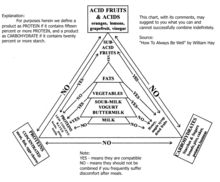- Hay diet
-
The Hay Diet is a nutrition method developed by the New York physician William Howard Hay in the 1920s. It claims to work by separating food into three groups: alkaline, acidic, and neutral. (Hay's use of these terms does not completely conform to the scientific use, i.e., the pH of the foods.) Acid foods are not combined with the alkaline ones. Acid foods are protein rich, meat, fish, dairy, etc., and "alkaline" the carbohydrate-rich starch foods like rice, grains and potatoes. It is also known as the food combining diet.
A similar theory, called nutripathy, was developed by Gary A. Martin in the 1970s.[1] Others who have promulgated alkaline-acid diets include Edgar Cayce, D. C. Jarvis, Robert Young, Herman Aihara,[2] and Victor A. Marcial-Vega.[3]
Contents
History
Dr. William Hay contracted Bright's disease (or what modern medicine refers to as Nephritis). Heart-dilated and near death, Dr. Hay began eating only natural[clarification needed] foods; his calorie intake dropped and his health improved. Dr. Hay spent the following decade studying naturopathy and food combining to reduce the acid end-product of digestion. He found that fruits and vegetables produce an alkaline end-product when they are fully metabolized, while processed and refined foods left a high acidic environment after digestion. His theories went on to encompass food-combining; whereas incorrect combination would cause even alkaline foods to leave a less desirable acidic digestion end-product.[4]
"Any carbohydrate foods require alkaline conditions for their complete digestion, so must not be combined with acids of any kind, as sour fruits, because the acid will neutralise. Neither should these be combined with a protein of concentrated sort as these protein foods will excite too much hydrochloric acid during their stomach digestion." - Dr. Hay, How to Always Be WellThe Hay System promoted the practice of eating three meals per day with meal one being alkaline foods only, meal two protein foods with salads, vegetables and fruit, and meal three comprising starchy foods with salads, vegetables and sweet fruit. There should be an interval of 4.0 to 4.5 hours between each meal. However, in 1935, Dr. Stewart Baxter showed that the pancreas secretes digestion enzymes simultaneously regardless of whether the food eaten is carbohydrates or protein.[5]
American artist Man Ray was a notable follower of the Hay Diet.[6]
Studies
The food-combining diet has been the subject of one peer-reviewed randomized clinical trial, which found no benefit from the diet in terms of weight loss.[7]
A study by Golay et. al. comparing the effects on obese patients of a low-calorie diet comprising 25% protein, 47% carbohydrates and 25% lipids (dissociated diet) and a 25% protein, 42% carbohydrates and 31% lipids (balanced diet) found no significant difference in the amount of weight loss in response to dissociated (6.2 +/- 0.6 kg) or balanced (7.5 +/- 0.4 kg) diets.[8]
See also
References
- ^ Rasso, Jack, Mystical Medical Alternativism, Committee for Skeptical Inquiry, Skeptical Inquirer, September/October 1995. available online
- ^ Aihara, Herman, Acid and Alkaline, Macrobiotic Foundation, 1986. available online ISBN 091886044X
- ^ York, Mary, An Acidic vs. Alkaline Body, Balanced Lifestyle. available online
- ^ Needes, Robin, Naturopathy for Self-healing: Nutrition, Life-style, Herbs, Homoeopathy, "Acid Alkaline Balance". available online
- ^ Cardwell, Glenn, The Skeptic, Nutrition: Food Combining, Vol 16, No 2. available online
- ^ Baldwin, Neil, Man Ray: American Artist, p. 170. available online
- ^ Golay A, Allaz A, Ybarra J, Bianchi P, Saraiva S, Mensi N, Gomis R, de Tonnac N (2000). "Similar weight loss with low-energy food combining or balanced diets". Int. J. Obes. Relat. Metab. Disord. 24 (4): 492–6. doi:10.1038/sj.ijo.0801185. PMID 10805507.
- ^ Golay A, Allaz AF, Ybarra J, Bianchi P, Saraiva S, Mensi N, Gomis R, de Tonnac N., "Similar weight loss with low-energy food combining or balanced diets", Int J Obes Relat Metab Disord. 2000 Apr;24(4):492-6
- Boyer, Josephine, and Katherine Cowdin (1934). Hay Dieting: Menus and Receipts for All Occasions. With a foreword by Dr. William Howard Hay. New York, New York: C. Scribner's sons.
- Habgood, Jackie (1997). The Hay Diet Made Easy: A Practical Guide to Food Combining With Advice on Medically Unrecognised Illness. Drawings by Alexandra Habgood. London: Souvenir Press. ISBN 0285633791.
- Hay, William Howard (1933). Health Via Food. Ed. and rev. by Rasmus Alsaker, with a special introduction by Oliver Cabana, Jr. First printing, June, 1929; Tenth printing, February, 1933. East Aurora, New York, Sun-Diet Health Foundation.
- Hay, William Howard (1935). Weight Control. New York: Hay System.
- Marsden, Kathryn. The Food Combining Diet: Lose Weight the Hay Way.
External links
- Hay Diet page
- Health Via Food by Dr. Hay.
- Easy Healthy Diet
Categories:- Diets
Wikimedia Foundation. 2010.

